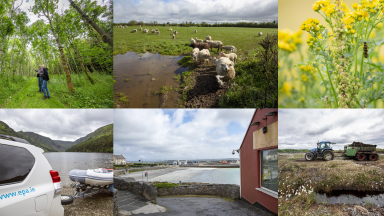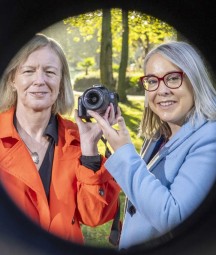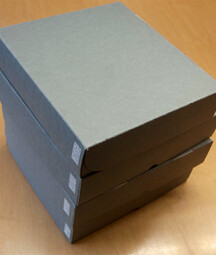By mid-January, I found myself in a room at the Library, shortlisted and being interviewed. When I left that interview (which, incidentally, I thoroughly enjoyed) I asked myself a simple but sobering question:
“If you’re offered this role, are you prepared for how deeply it will challenge you?”
The answer came from David Bowie: “Nothing worth doing happens when you're completely comfortable.”
When the phone call came offering me the position, I was over the moon. It took time to fully absorb the enormity of this award. By that I don’t mean the enormity of fulfilling my project strategy, I trusted I would do that. I mean that a resulting selection of photographs would become part of the National Collections in the National Library of Ireland Photographic Archives, a massive honour and enviable legacy by any standard.
A Strategy Rooted in People and Place
My career to date provided me many tools to achieve the Residency objectives: I had already included environmental issues in photo projects; I had worked with archives in my career in publishing; I had writing and text editing skills and as a book designer, I was used to absorbing new information and using it creatively. I vowed to do everything in my power to create a resource that reflected the intentions of both stakeholders with integrity, and diversity.
Laura Burke, General Director of the EPA, asked that ‘human values’ be at the heart of this residency, and that spoke to my own strategy. The aim was to cover people, places and initiatives on myriad topics, from large scale like data centres, to small scale local stories, and everything in between. I had a clear boundary: I am a photographer and gatherer of facts. I would turn up, and then let either those I met, or verifiable research, tell the story.
How the Project Unfolded
The plan was simple in theory:
Visit all 26 counties of the Republic of Ireland in one year
- Travel using public transport and e-bike
- Cover at least two environmental topics in each county
- Capture both general landscapes and portraits of those involved
- Recreate historical photographs from the NLI’s digital archive to explore environmental change
- Share stories via social media, events, and an upcoming online exhibition
What followed was a year-long odyssey: part documentary project, part adventure, part environmental time capsule.
The Joy of the Journey
For over a year, I threw myself into the ReViewing Ireland project, eschewing a social life almost entirely, only appearing for special occasions like my son Rúaidhrí’s marriage to the beautiful Helen. At project’s end, I welcomed my first grandchild, Doireann! It was a whirlwind of a year, about one third of it spent preparing trips, one third on the road taking photographs, and one third doing research and writing photograph captions.
Throughout the year, I had tremendous support from dozens of people from the National Library and the EPA. I won’t mention names here, as there are too many, but every single person I met in so many different roles is responsible for the final project, and their expertise was given to me with great generosity. It was such a pleasure to meet people who love their work, and I own them a huge debt of gratitude.
Initial preparations for ‘ReViewing Ireland’ entailed making a long list of subjects to cover, and putting it beside a list of the 26 counties, cross referencing them while making sure not to cover any one issue twice. At the outset I thought I would organise all the trips first, then set off like Shackleton fully equipped and full of purpose. It didn’t work like that. I had to befriend chaos, not easy for someone as organised as I like to be. I had to allow for the vagaries of a multitude of other people and outside forces. So when I say one third of the year was preparation, that is an accumulation of pockets of time over the course of the year, not all at once at the start.
Issues Covered
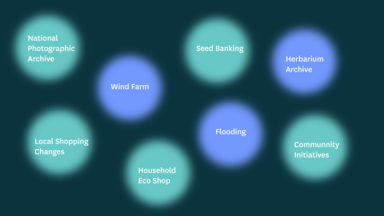
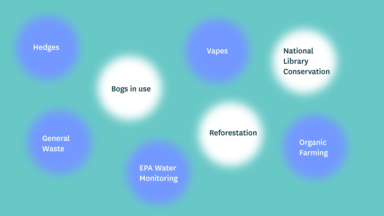
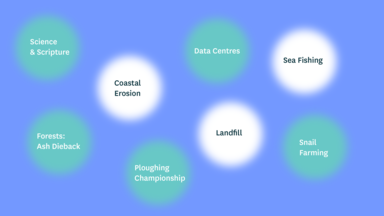
Lessons from the Road
There were times I got confused, and going to Thurles booked a hotel in Nenagh (thankfully realising it before departure). I had to frequently cancel and rebook trains to accommodate the happenstance that was the hallmark of the project. There were times I momentarily forgot what town I was in. To-do lists, I discovered in this new chaotic reality, were a waste of time. When meeting people fell through in a county, I had to find other subject matter, and rediscovered the value of rural printed newspapers – excellent sources of inspiration which could not be found online. Sometimes people I met with one topic in mind, surprised me by being involved in more interesting issues, like Paddy McQuaid of ‘Drumlin Trail Bike Hire’ in Knockafubble, Monaghan, whom I phoned to rent a bike, but chatted to at such length he offered to meet. So instead of renting a bike, he took time out to bring me to a unique waste water treatment collaboration between the village of Glaslough and Castle Leslie. I learnt to run with all manner of unexpected twists and turns, which made it a true adventure.
One third of the year being on the road was likewise done in pockets of time over the course of the year. To say I loved being on the road is an understatement. Some of my best memories are cycling alone on empty back roads, the fleeting scents of grasses and flowering shrubs, looking over hedges and into ditches, spotting farms and forests and rivers; wildlife, butterflies, birds bursting out of trees; dogs running out of gardens to chase me for a few meters and all the while Google Maps barking orders to keep me from getting lost.
I decided to leave the long Irish Christmas and Easter periods free of travel, using those times for research and caption writing. On the road, I wrote rough drafts of captions while the information was fresh in my memory, sometimes staying on an extra day to do so because once home, there were many distractions. I voice recorded interviews, then used voice-to-transcript. Editing these transcripts was a huge job, but it was crucial to the photo captions containing the words of those in the know.
The Photography
Ultimately, of course, photography is what the year was all about. My primary ambition on each trip was to get the most interesting, informative and beautiful photographs possible. One of my favourite photographs is a huge mountain of metal glinting in the sun with a blue sky and wispy clouds behind it, so it’s not just about the classically beautiful. I loved taking portraits of people, and tried to do this after they had been interviewed, when we had gotten to know each other a little and were more relaxed.
Not everyone will be interested in the tech part of the project, but for those who are I will cover the basics, and after that, write about four of the counties visited, including some photographs. So skip the next two paragraphs if you wish!
My kit included three cameras: two Canon EOS 5D Mark III, and one Canon EOS 5DSR 50.6 megapixel; lenses were 11-24mm ultra-wide angle, 24-105mm, 35mm, 135mm, 80mm and 150-600mm zoom. Add to that the flash, tripod or monopod, power and charging accessories and a laptop for on-the-road work, and you can see why the haul of luggage on most trips was heavy! The huge suitcase I brought everywhere was not full of clothes, but camera extras and healthy food. Hotel food I love, but it doesn’t love me, and I have no problem admitting I brought my favourite coffee and a cafetiere everywhere with me.
Photographs are catalogued and processed in Adobe Lightroom, and exported as 16-bit tiffs to an external hard drive. The size of these files on average range from 80MB to 140MB. When I export them, I let them open in Photoshop Beta, where I double check the metadata to ensure it includes what is essential for the National Library Digital Archives. For example: headlines, captions, keywords, dates, times, GPS, and very important, the copyright information. All photographs will soon be available to the public on nli.ie, but photographs including people are copyright so as to remain non-commercial (NC).
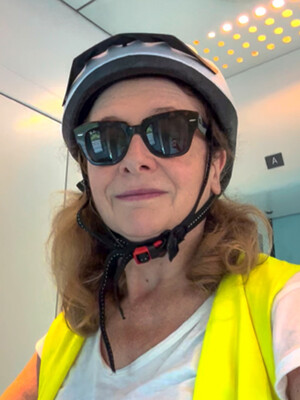
Paula T Nolan
Highlights from Four Counties
In order to give a flavour of the year, what follows are stories from four counties:
1) CLARE: Hometree
In County Clare, I visited Hometree headquarters on 16.5 acres of land between Ennistymon and Lahinch. As the name suggests, is about all things trees and forests. The work of Hometree is to establish and conserve permanent native woodland in Ireland, encouraging land regeneration and biodiversity through afforestation, restoration and education.
What began as a purely volunteering initiative quickly grew, and currently there are nineteen members of staff, and around thirty volunteers. They have eight people on their Board of Trustees, and recently employed an outside Human Resources company.
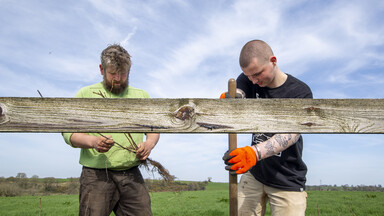
Jeremy Turkington, Seed Collector and Seed Bank Coordinator, helping with the tree planting at Dromoland along with Enda O’Brien, one of the volunteers from Hometree’s Spring Experience Week. Canon EOS 5D MarkIII, EF11-24mm at 23mm, 1/100, f/10, 100 ISO
2) DONEGAL: SourcedBySab
In County Donegal I visited SourcedBySab in Letterkenny.
SourcedBySab is a physical and online concept store that specialises in sourcing handpicked premium vintage and sustainable streetwear from around the globe. The SourcedBySab clothing range is rooted in the circular economy, with pieces sourced either second-hand, or unworn old stock. The physical store opened in Letterkenny, County Donegal, in 2021 in what had been a Covid centre. Sab (Sadhbha Medlar) was the concept originator. They are Ireland’s No.1 Stüssy supplier and they stock vintage single-stitch tees mostly made pre-mid-90s and of a quality hard to find anymore.
SourcedBySab has won several accolades including ‘Sustainable Superstars’ by the Letterkenny Chamber of Commerce 2022 and have appeared in an Irish Times ‘What’s Hot’ feature.
As well as the clothing business, in their physical store they host all kinds of events: music, yoga, workshops, meditation, mental health and more. Their core belief is to share and work together for the benefit of all, while of course making a living at the same time.
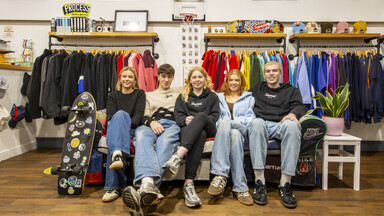
Photograph shows part of the interior of SourcedBySab. On the sofa, from left to right: Gillian Reynolds, Oisin Morris, Sadhbha Medlar, Maeve Medlar and Thomas Reynolds. Canon EOS 5D MarkIII, EF11-24mm at 11mm, 1/125, f/10, 100 ISO
3) WATERFORD: EPA Estuary Monitoring
From Donegal we go right to the other end of the country, to Waterford. Here I joined the EPA Transitional and Coastal (TraC) team monitoring Waterford Estuary. I met with Daryl Gunning and John Keogh aboard an angling boat belonging to skipper, Brendan Glody, out of Dunmore East.
In this photograph Daryl lowers a monitoring probe or sonde into the water. Water samples are collected from the surface and bottom at about 12 sampling sites in the estuary. These samples are then bottled and stored in a cooler box and collected by a courier to take to the EPA laboratory in either Dublin or Monaghan.
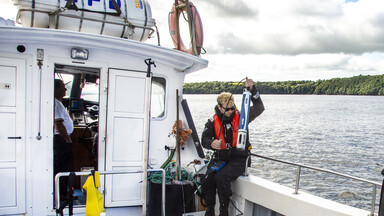
Daryl Gunning lowers a monitoring probe or sonde into the water. Canon EOS 5D MarkIII, EF24-105mm at 24mm, 1/160, f/11, 100 ISO
4) LAOIS: Abbeyleix
Next we go to Laois, to Abbeliex. The primary reason for this trip was to visit Abbeyleix bog, but when I was there, I could not get over the huge number of massive container trucks going up and down the narrow streets, so I asked locally why this was, because the air was foul. Turns out it is hauliers avoiding the tolls on the motorway. Many of the cars going through the town seem to be doing the same thing, if you look at the numbers.
Jill Cushen in the Irish Times (2021) wrote that the Residents of Abbeyleix had expressed concerns over air and noise pollution as significant numbers of heavy goods vehicles continued to travel through the town, despite it being bypassed by a tolled motorway since 2006. Transport Infrastructure Ireland confirmed 43,256 vehicles were driving through the town each week, 4,300 of which were heavy goods vehicles. The population of Abbeyleix is c.1,900.
When we look at the old photograph from the NLI Collection taken some time between 1900–1920, we can get a sense of how the town should look and feel. In the new photograph, the huge truck turning onto main street almost stops us seeing another huge truck to the left of the photograph.
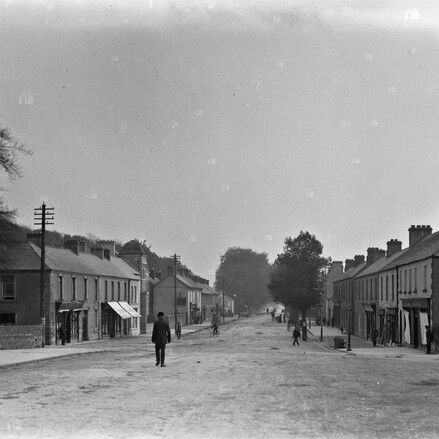
THEN: Abbeyleix, 1900–1920, Eason Photograph Collection (Eas 2649)
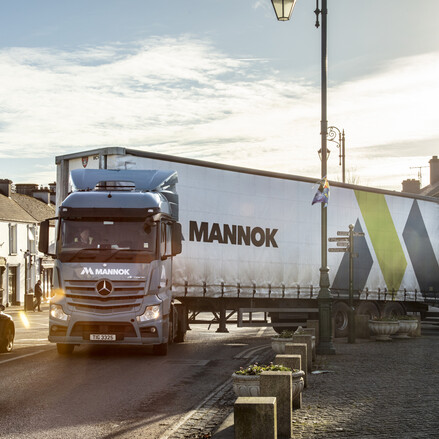
NOW: Abbeyleix, 2025. Canon EOS 5D MarkIII, EF24-105mm at 24mm, 1/80, f/14, 100 ISO
Travelling Sustainably
I can safely say 98% of all travel for the ‘ReViewing Ireland’ project was using public transport or ebike. I was faithful to this with very few strategic exceptions. Sometimes taking lifts with people was an opportunity to interview them, or just chat and find out more about the issue to hand. Sometimes it was pure good manners. Once it was because of time constraints on revisiting some counties to take Then & Now photographs.
I will describe the experience of using public transport to travel to all 26 counties, and within those counties.
-
Irish Rail offer a good value, easy to book (and cancel!) train service, and I found it almost always reliable. Taking my bike by train made this project hugely more doable, allowing access to remote places from the train station destination.
-
Bus Eireann run a great service as well, though often turning up late or very late.
-
Private bus services are more reliable, but unlike Bus Eireann do not serve the smaller towns.
-
The biggest surprise of the year on public transport was the Local Link buses – they are fantastic! They can take you to very far flung places, for example, Tralee to Dingle, or Cahirsiveen to Tralee, and I found then to be very much on schedule.
Finding where Local Link buses stop or drop off became something of a ‘hunt the thimble’, as there are rarely any signs. So my advice is to ask locals. Most won’t know (“I haven’t been on a bus since the 1980s,” said one local) but you’ll eventually find one who will. In Cahirsiveen I asked a Local Link bus driver if my bus to Tralee stopped at the same spot as his bus.
“It does,” he said, “I saw it going up the road so it’ll be back down here shortly.”
So I said to him, “How am I supposed to know where the bus stops if there’s no sign?”
“Sure amn’t I after just telling you,” he said.
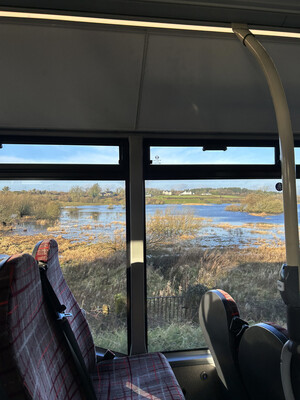
Stunning views from Local Link bus from Dromod to Mohill, Leitrim. Photo taken with iPhone 14
Final Thanks
In conclusion, I would like to wholeheartedly thank the National Library of Ireland and the Environmental Protection Agency for entrusting to me the role of Photographer-in-Residence, and for all their hard work, assistance and expertise throughout year. I am likewise grateful to every single person who took part, and to those who guided, encouraged and supported me in the making of ReViewing Ireland. This project has a cast of hundreds.
